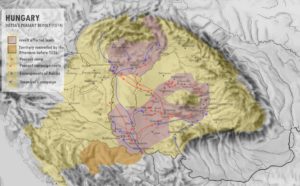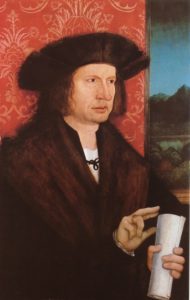The First Printed Map of Hungary: the Tabula Hungarie 1528

The Tabula Hungariae or Lazarus Map is the first surviving printed map of Hungary, probably made by the Hungarian Deacon Lazarus before 1528. The map, which is unique in its printing technique, was inscribed on the UNESCO World Heritage List on June 19, 2007. The only map of the medieval Kingdom of Hungary after the Battle of Mohács exists today in a single copy.

The map shows the areas in the south of the country occupied by the Turks in different colors. Since it shows only the southern areas outside the border, its purpose may have been to prepare against the Turks and to show the system of fortifications. The detail of the settlements depicted is remarkable for the fact that some of them disappeared during the battles with the Turks and the period of Ottoman occupation.





In medieval Hungary, from the second half of the 16th century, the southern border defense system – the construction of which became increasingly urgent due to the Ottoman-Turkish armies intending to attack the heart of Europe – was formed by two chains of fortifications running parallel to each other for about 100 kilometers. The first, mostly outside the borders of the Kingdom of Hungary, stretched from the border of Walachia to the Adriatic Sea, in territories conquered from the fallen Balkan states.

The outer line of defense followed the line of the Lower Danube from Szörényvár to Nándorfehérvár (now Belgrade), and from there it ran along the Száva River through the castles of the Srebrenica Banat. From here it curved in a great arc towards the Bosna River valley, reaching the Adriatic coast via Banja Luka, Jajca and Knin, Klis (now Klis), and Skardona (now Skradin). Behind this line of defense lay the second line of defense, which ran from Temesvár to Nándorfehérvár, followed by a chain of smaller fortresses in the Szerémség, partly along the Száva River, and then, following the valley of the Una River, the fortifications reached the Adriatic Sea at Zengg. The strongest point of this defense system was Nándorfehérvár, while the least fortified part was the southern border of Transylvania.

Older historical events are marked by diagrams, battle scenes (e.g. at the site of the Battle of Mohács), and inscriptions, while the area of the Turkish invasion of 1526 is marked by a series of dots. At the bottom, there are descriptions of the country in Latin and German. We can read the following text on it:

“Here a pious Christian can see how the Turkish Emperor, by the divine decree, conquered Bosnia, Rác-land, Hungary and Bulgaria, the Vendland, Serbia, and Dalmatia in a very short time.
All this is shown by the red color, the yellow color still represents the Christians whom the Almighty God is keeping under Your protection. Everything inside the dotted line was destroyed by the Turks after they won the battle in 1526″.

“The Hungarians have ruled this country for 600 years, but now the Turks have also invaded it, so just as a man must die and perish, so must the nation in time”.




Dear Readers, I can only make this content available through small donations or by selling my books or T-shirts:
Please, feel free to support me with a coffee here:
You can check out my books on Amazon or Draft2Digital, they are available in hardcover, paperback, or ebook:
https://www.amazon.com/dp/198020490X or at https://books2read.com/b/boYd81

My work can also be followed and supported on Patreon: Become a Patron!http://Become a Patron!
[wpedon id=”9140″]

https://hungarianottomanwars.myspreadshop.com/all



